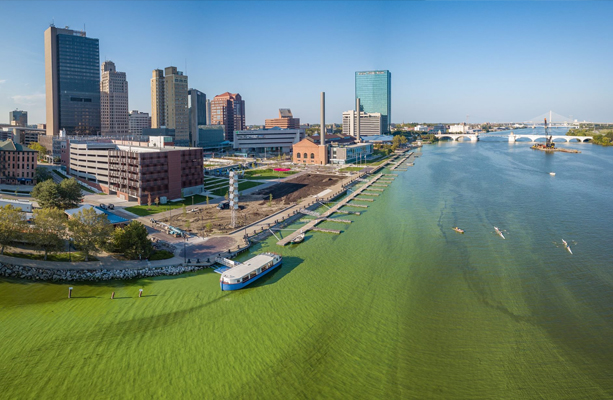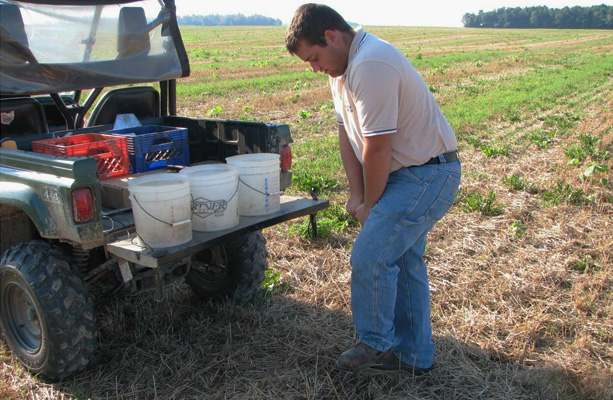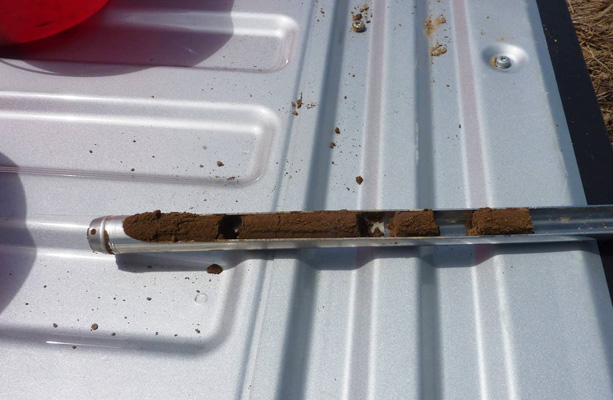Sounding the Alarm on Dissolved Reactive Phosphorus
Developing a Toolbox to Reduce Dissolved Reactive Phosphorus from Farms
- By admin_glpf
Nothing makes headlines like residents who are told not to drink the water from their taps. The Toledo water crisis in 2014 and the “Lake Erie is Dead” declaration in the 1960s are of the same problem—too many nutrients in the water.
Nutrients like phosphorous, commonly used to fertilize crops, will also fertilize aquatic algae and cause it to bloom when found in excessive amounts. When these algae die and decay, they deplete the water’s supply of available oxygen, harming all other oxygen-loving life in the water system. Conditions in Lake Erie in the summer of 2014 created a massive algae bloom that caused unsafe water for 500,000 residents of Toledo and the surrounding areas.

In the 1960s and 1970s, Lake Erie’s pollution problem was the result of phosphorus pollution from poorly treated sewage. More recently, researchers discovered that for every pound of phosphorous released from industry and sewage, three pounds were released from farm fields in the region.
That was an important reckoning and it became clear that agricultural practices needed to become part of the solution to Lake Erie’s problems. Reducing the harmful effects to the aquatic system would require effective nutrient management on farms.
Evolving Farming Practices
Phosphorous comes in two forms: particulate phosphorus that attaches to and is transported by sediment, and one that dissolves in water known as dissolved reactive phosphorus (DRP). It is this dissolved phosphorus that contributes most to algae blooms.
By the mid-1990s, farmers were learning how to make particulate phosphorus stay put on the land by changing to tillage practices that disturbed the soil as little as possible. Those practices were successful, but DRP was beginning to flow off of farms and into the lake at increasing rates.
The next solution set would need to incorporate management practices informed by how phosphorus accumulates in the soil and how it is transported, ultimately to the lake.
In 2007, the Great Lakes Protection Fund supported a project team led by Heidelberg University to reduce DRP in the Ohio Lake Erie basin by developing new ways to measure phosphorus levels in soil and helping farmers to limit unnecessary phosphorus additions on fields, saving money in the process.
“There was $88 million of lost value from phosphorus pollution in one year, $16 an acre for every acre in [the Maumee and Sandusky River watersheds in Ohio]. That generally brings a pretty big gasp from people when you say that.”
- Pete Richards, Former Senior Research Scientist at Heidelberg’s National Center for Water Quality Research
The team led by David Baker, now professor emeritus at Heidelberg, worked with hundreds of people representing all members of the ag supply chain to develop the largest soil data sets on the topic of phosphorus stratification (including analysis of 4,270 soil samples). They were among the first to understand that most DRP accumulates in the top two inches of soil.


“The traditional soil testing farmers used to evaluate the need for fertilizer application looked at a zero-to-eight inch column of soil. However, from an environmental standpoint, the most critical part of the soil is the top zero-to-one inch or zero-to-two inch,” said Baker.
“We found that when we looked at a zero-to-two inch soil profile and compared with a zero-to-eight inch soil profile, there was a much higher concentration of phosphorus in the surface.”
- David Baker, Professor Emeritus, Heidelberg University
The team developed and finalized the protocols for stratified soil testing and developed a BMP toolbox for DRP runoff and management options so farmers could take actions on the land based on the detection of phosphorus levels.
The team made significant contributions to and have become important voices on the topic of phosphorus stratification in soils and on phosphorus transport and its impacts on water quality. The team carefully assessed changes to long-accepted practices—like reduced tillage agriculture—which had been assumed to be beneficial but, instead, contributed to DRP loading in Lake Erie.
“We implemented conservation tillage widely, as a strategy to reduce erosion, to reduce the loss of sediment and phosphorous attached to it. Data showed that in fact is what happened. It did what we intended it to do,” said Richards. “We saw clear benefits from conservation tillage in terms of reducing erosion… but it also had an unintended consequence for contributing to the stratification of phosphorus in soil.”
The team’s work led to recommendations for state and regional actions. They were active voices in the deliberations for the Ohio Lake Erie Phosphorus Task Force and the Great Lakes Water Quality Annex 4 that included calling for a 40 percent reduction in the dissolved reactive phosphorus loads to Lake Erie.
“You don’t turn around ships like this overnight. Our role was primarily exploring why it is happening and trying to figure out what to do about it. We’ve learned a lot in the process. Great Lakes Protection Fund gave us the freedom to take it where it seemed to go, which was very valuable,” Richards said.
—
Start a Conversation
At the Fund, our goal is to build something—together—that delivers impact. You have an idea and a strategy in mind and we have a basin-wide perspective and experience launching new initiatives. We strongly encourage you to contact us to discuss an idea, whether fully formed or not, as a first step.
Email us at startaconversation@glpf.org